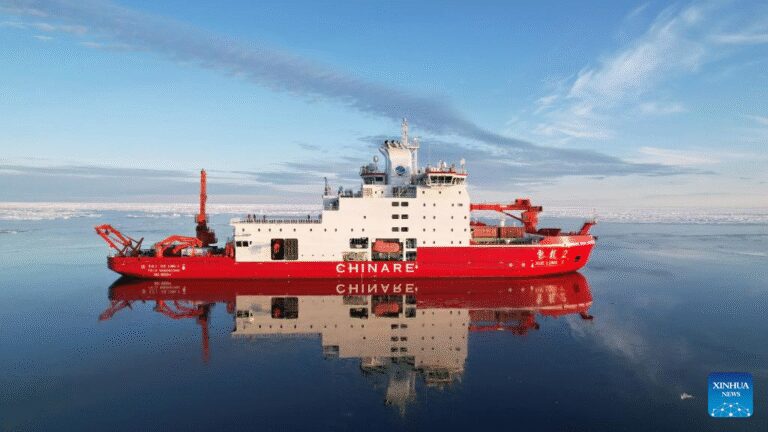
A drone photo taken on July 24, 2025 shows China’s research icebreaker Xuelong 2 conducting scientific research in the Arctic Ocean. China’s research icebreaker Xuelong 2, or Snow Dragon 2, arrived in Shanghai on Friday, marking the completion of the country’s hitherto largest Arctic Ocean scientific expedition. A total of 100 members of China’s 15th Arctic Ocean scientific expedition were aboard the vessel. Organized by the Ministry of Natural Resources, this round of Arctic survey was jointly carried out by four vessels, including Xuelong 2, Jidi, Shenhai-1 and Tansuo-3. This Arctic expedition has further enhanced China’s understanding of the rapid changes in the Arctic Ocean and their impacts, providing important support for a deeper understanding and effective response to global climate change, according to the researchers. (Xinhua/Liu Shiping)
SHANGHAI, Sept. 26 (Xinhua) — China’s research icebreaker Xuelong 2, or Snow Dragon 2, arrived in Shanghai on Friday, marking the completion of the country’s hitherto largest Arctic Ocean scientific expedition.
A total of 100 members of China’s 15th Arctic Ocean scientific expedition were aboard the vessel.
Organized by the Ministry of Natural Resources, this round of Arctic survey was jointly carried out by four vessels, including Xuelong 2, Jidi, Shenhai-1 and Tansuo-3. This Arctic expedition has further enhanced China’s understanding of the rapid changes in the Arctic Ocean and their impacts, providing important support for a deeper understanding and effective response to global climate change, according to the researchers.
During the expedition, the Xuelong 2 and Jidi vessels completed comprehensive marine environment surveys and manned deep-sea diving support tasks in the Chukchi sea plateau, the Canada Basin and the central region of the Arctic Ocean. They have made significant progress in multi-disciplinary comprehensive investigations in the ice edge areas and three-dimensional coordinated observations of air, ice and sea, according to the expedition team.
Notably, the two vessels carried out collaborative operations in high-latitude waters, filling the gap in observation data in the high-latitude areas of the Arctic Ocean, which is expected to provide support for improving marine environment forecasting capabilities. ■

Scientific expedition team members retrieve a benthic lander while conducting scientific research in the Arctic Ocean aboard China’s research icebreaker Xuelong 2, Aug. 14, 2025. China’s research icebreaker Xuelong 2, or Snow Dragon 2, arrived in Shanghai on Friday, marking the completion of the country’s hitherto largest Arctic Ocean scientific expedition.
A total of 100 members of China’s 15th Arctic Ocean scientific expedition were aboard the vessel.
Organized by the Ministry of Natural Resources, this round of Arctic survey was jointly carried out by four vessels, including Xuelong 2, Jidi, Shenhai-1 and Tansuo-3. This Arctic expedition has further enhanced China’s understanding of the rapid changes in the Arctic Ocean and their impacts, providing important support for a deeper understanding and effective response to global climate change, according to the researchers. (Xinhua/Liu Shiping)

A drone photo taken on Sept. 26, 2025 shows China’s research icebreaker Xuelong 2 berthed at a dock in Shanghai, east China, Sept. 26, 2025. China’s research icebreaker Xuelong 2, or Snow Dragon 2, arrived in Shanghai on Friday, marking the completion of the country’s hitherto largest Arctic Ocean scientific expedition.
A total of 100 members of China’s 15th Arctic Ocean scientific expedition were aboard the vessel.
Organized by the Ministry of Natural Resources, this round of Arctic survey was jointly carried out by four vessels, including Xuelong 2, Jidi, Shenhai-1 and Tansuo-3. This Arctic expedition has further enhanced China’s understanding of the rapid changes in the Arctic Ocean and their impacts, providing important support for a deeper understanding and effective response to global climate change, according to the researchers. (Xinhua/Liu Shiping)

The scientific expedition team members deploy ice-based buoys in the high-latitude waters of the Arctic Ocean, Aug. 25, 2025. China’s research icebreaker Xuelong 2, or Snow Dragon 2, arrived in Shanghai on Friday, marking the completion of the country’s hitherto largest Arctic Ocean scientific expedition.
A total of 100 members of China’s 15th Arctic Ocean scientific expedition were aboard the vessel.
Organized by the Ministry of Natural Resources, this round of Arctic survey was jointly carried out by four vessels, including Xuelong 2, Jidi, Shenhai-1 and Tansuo-3. This Arctic expedition has further enhanced China’s understanding of the rapid changes in the Arctic Ocean and their impacts, providing important support for a deeper understanding and effective response to global climate change, according to the researchers. (Xinhua/Liu Shiping)

A Conductivity, Temperature, and Depth (CTD) sensor is retrieved to China’s research icebreaker Xuelong 2, Sept. 8, 2025. China’s research icebreaker Xuelong 2, or Snow Dragon 2, arrived in Shanghai on Friday, marking the completion of the country’s hitherto largest Arctic Ocean scientific expedition.
A total of 100 members of China’s 15th Arctic Ocean scientific expedition were aboard the vessel.
Organized by the Ministry of Natural Resources, this round of Arctic survey was jointly carried out by four vessels, including Xuelong 2, Jidi, Shenhai-1 and Tansuo-3. This Arctic expedition has further enhanced China’s understanding of the rapid changes in the Arctic Ocean and their impacts, providing important support for a deeper understanding and effective response to global climate change, according to the researchers. (Xinhua/Liu Shiping)

